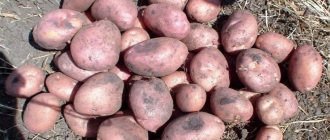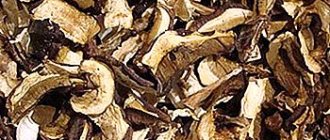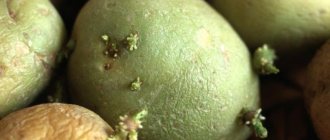Chemical composition of blue potatoes
In addition to its bright and original appearance, purple potatoes have other beneficial properties.
The energy value in 100 grams of product is 72 kcal, protein content is 2 g, fat is 0.4 g, carbohydrates are 16 g.
Purple tubers have a lot of vitamins . These are ascorbic, folic, pantothenic acid, beta-kerotene, B vitamins (B1, B2, B6), E, PP, A.
The amount of microelements exceeds all expectations: iron, iodine, aluminum, fluorine, zinc and many others.
There are also many macroelements: calcium, potassium, magnesium, sodium, fluorine - everything that is needed for the normal functioning of the body. To fully absorb the vitamins, you need to add other vegetables to the potatoes. Then the diet will be rich and complete.
Benefit
To introduce purple potatoes into the menu, you need to understand its pros and cons, benefits and harms. The scales with the beneficial properties of the blue root vegetable clearly outweigh :
- Thanks to a sufficient amount of ascorbic acid, purple potatoes have a beneficial effect on the immune system. Taking care of your immune system is especially important in autumn and winter.
- The content of dietary fiber ensures good digestion, problems with stool disappear, and the intestines work like clockwork. And starch envelops the walls of the stomach, protecting it from damage. Flatulence is eliminated.
- Having cleansing properties, potatoes tidy up the body's cardiovascular system. The appearance of blood clots in blood vessels is neutralized, and the risk of a heart attack is minimized.
- The beneficial substances of tubers help fight poor eyesight and ophthalmological diseases.
- The presence of antioxidants has a slowing effect on the aging process.
- Folic acid in the vegetable reduces the risk of anemia and increases hemoglobin. This makes purple potatoes a must-have item on a pregnant woman's menu.
- People suffering from high blood pressure need this vegetable because it reduces it.
Purple power or health effects
Blue potatoes are a good source of many minerals (potassium, magnesium, iron, calcium) and vitamins (A, B1, B2, B6, C). In addition to carbohydrates, the root vegetable also contains a certain amount of fiber and protein. More interesting compounds are the above-mentioned anthocyanins, carotenoids, phenolic and chlorogenic acids.
According to a scientific study conducted in Scranton, Pennsylvania, people who consumed 6-8 small potatoes with lunch or dinner for 1 month suffered much less from high blood pressure and excess body weight. Another study found that regular consumption of this variety reduced levels of cancer markers associated with colon cancer.
The study, presented at the National Congress of the American Chemical Society in Denver, Colorado, found that consuming blue potatoes helped lower blood pressure in study participants (compared to participants who did not consume the colored root vegetable). This effect on pressure is associated with the positive effect of potatoes on capillaries and blood vessels.
Blue potatoes have high concentrations of an important phytochemical, chlorogenic acid. Its effect on blood pressure has been proven previously.
Other effects
As with any fruit or vegetable, the rich, dark color of blue potatoes indicates their high nutritional value.
- Rich in strong antioxidants, anthocyanins. Anthocyanins, which are among the flavonoids, are best known for their ability to strengthen the immune system and fight cancer. These antioxidants are also found in blueberries and pomegranates.
- Anthocyanins are also beneficial for health due to their ability to protect the integrity and structure of DNA and support the production of cytokines necessary for the normal functioning of the immune system.
- Powerful antioxidants also have anti-inflammatory properties and help protect the health and integrity of capillaries by strengthening their membranes.
- They also play an important role in regulating estrogen activity, which helps reduce the risk of hormone-related diseases.
- Blue potatoes do not burden the digestive system, so they are often recommended for people suffering from stomach ulcers or those who have suffered from food poisoning.
- The root vegetable has a diuretic effect. But, on the other hand, when consuming it, caution is needed for people whose doctor has recommended reducing their potassium intake due to kidney problems.
- On the contrary, potassium is suitable for people who have problems with high blood pressure. Kukuamine, present in the purple root vegetable in relatively large quantities, is also useful for them (the largest percentage is found in boiled potatoes, the smallest amount remains after frying).
- Carbohydrates also have a positive effect on the body by providing energy to the body. Thanks to them, a person is satiated for a long time. In addition, due to the gradual absorption of starch, sugar levels are maintained at the proper level.
And a little more about the beneficial properties. Blue Potato supports the treatment of the following health problems:
- Colds.
- Diseases of the paranasal cavities.
- Rheumatism, rheumatoid arthritis.
- Gout.
- Stomach problems.
- Heartburn.
- Edema.
- High cholesterol.
- Hyperacidity.
- Stomach ulcer.
- Gastritis.
Blue potatoes are a good source of many minerals (potassium, magnesium, iron, calcium) and vitamins (A, B1, B2, B6, C). In addition to carbohydrates, the root vegetable also contains a certain amount of fiber and protein. More interesting compounds are the above-mentioned anthocyanins, carotenoids, phenolic and chlorogenic acids.
Tags: harm, potatoes, benefits, blue
About the author: admin4ik
« Previous entry
Contraindications for use
Potatoes should be eaten with caution:
- Diabetics . A fairly high content of starch and sugars will increase blood sugar.
- Hypotonics . The product lowers blood pressure, which is of no use to people whose blood pressure is already low.
- Obese people . Purple potatoes cannot be called dietary, so if you are obese, it is better to give up the vegetable or minimize its quantity.
What are the varieties of potatoes with purple flesh called?
Breeders have become seriously interested in breeding varieties with purple flesh, so now there are quite a lot of them. But domestic gardeners very often call this variety much simpler: blue potatoes. However, this does not change the essence.
Potatoes with purple flesh are still at the stage of breeding development, but now you can purchase some varieties with different color intensities for your summer cottage. The most popular include:
- French purple truffle;
- Black woman;
- Chinese truffle;
- Witelotte;
- Gourmet;
- Russian black.
Comparison with red and white potatoes
| Indicators | Violet | Red | White |
| Nutritional value per 100 g. | Energy value – 72 kcal, Proteins – 2 g, fats – 0.4 g, carbohydrates – 16 g. | Energy value – 87 kcal, Proteins – 2.3 g, fats – 0.2 g, carbohydrates – 17.8 g. | Energy value – 69 kcal, Proteins – 1.7 g, fats – 0.1 g, carbohydrates – 13.3 g. |
| Alimentary fiber | 1,6 | 1,8 | 2,4 |
| Water | 80,1 | 76,67 | 81,58 |
| Color of peeled root vegetable | From purple to pink | White-yellow | White milky |
| Peel size | Fat | Thin | Thin |
| Shelf life | Big | Big | Relatively small |
| How it boils | Badly | Fine | Fine |
The comparative table shows that different types of potatoes are good in their own way for certain purposes. White is more useful for dietary nutrition. For an original presentation, purple is best.
Advice
Each type of root vegetable behaves differently when cooked. It is better to boil purple and serve in large cut pieces, as it does not boil well and holds its shape well. Red and white potatoes cook well, so mashed potatoes and casseroles are their strong point.
Use in cooking
The Russian people love potatoes for their variety.
What can you cook with it! Purple does not lag behind its brothers.
It will take its central place on the festive and everyday table due to its color and taste.
Guests and family members will eat everything without a trace: fried in oil in a frying pan, mashed, boiled and drizzled with butter, baked with meat in the oven, stewed with vegetables or grilled, in soup.
In folk medicine
Purple potatoes help with many problems . Traditional healers recommend eating it for high acidity and gastritis, high blood pressure, constipation, myopia and cataracts, for the prevention of cardiovascular diseases. For allergic rashes, burns, age spots, lotions made from raw purple potatoes help. It is also perfect for making nourishing face masks, improving the color and condition of the skin.
A mask of boiled potatoes with sour cream is popular among women over 40 years old. For swelling and dark circles under the eyes, people use vegetable compresses. You can put raw cut slices or compresses (grated raw potatoes wrapped in gauze) under your eyes.
Potato decoction is used in folk medicine for colds and throat infections. The patient breathes in the vapors of the boiled vegetable, and improvements are not long in coming.
Important!
The juice of raw purple potatoes does an excellent job of cleansing the body and removes all toxins.
Growing the variety
How to grow such potatoes in your summer cottage
Planting is carried out in two ways: traditional (tubers) and seeds. For the second option, you first need to germinate the seeds, then grow seedlings at home, and then transplant them into open ground. Seeds are planted in April, and seedlings are transplanted into open ground no earlier than in mid-May.
Properly germinated planting material of purple potatoes will ensure fast, uniform germination and early setting of tubers
When planting tubers, the planting period is the same as for regular potatoes.
Soil preparation
They try to choose light soil for planting purple potatoes. Oxygen should easily penetrate into it and excess moisture should not stagnate. An excellent option would be neutral sandy loam, as well as floodplain and soddy-podzolic soils. Before the onset of the first frost, a rough initial digging of the selected area is carried out . During frosts, the pest larvae that were in the turned-out soil will die.
The area for colored potatoes should be dug up in the fall with the addition of potassium fertilizers and superphosphate
With the onset of warmth, when the minimum soil temperature reaches 5°C, planting begins. First, the soil is dug up again and holes are prepared with the addition of wood ash. The distance between the rows should be at least half a meter, and between the holes it is maintained at a level of 30 centimeters . The planting depth reaches 10 centimeters.
Planting and care
If the soil in the selected area is dry, then watering should be carried out at least three times: immediately after emergence, during flowering and immediately after it. In conditions where there is no rain, plants need to be irrigated at least once a week. If there is a lot of moisture, fungal diseases will develop, and if there is not enough moisture, the plantings may dry out.
After purple potatoes sprout, they must be regularly weeded and weeds removed . When a crust appears on the soil, you should loosen it. The beds are regularly treated with preparations against the Colorado potato beetle, late blight and other common pests and diseases.
Loosening the soil and hilling potato beds
For now, purple potatoes are classified as delicacies. But thanks to the hard work of domestic breeders, it is quite possible that it will soon become available to any category of the population, as it brings benefits to the human body. This would be wonderful, since the beneficial properties of this product make us seriously think about the industrial scale of growing colored potatoes in our country.











